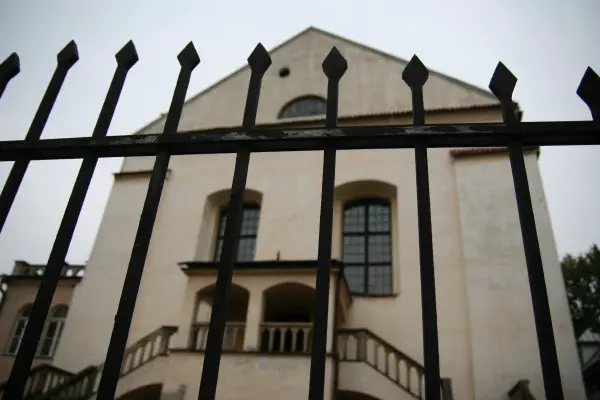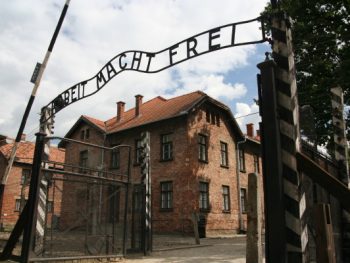Supposedly, my hometown of Chicago has the largest ethnically Polish population outside of Poland. So for me, coming to Poland was not a great culture shock as I’d already had my fill of Pierogies and Golabki back in Chi-town. Krakow is one of the country’s oldest, best-preserved cities. It miraculously survived WWII, leaving behind beautiful medieval churches, baroque architecture, and eerily quiet synagogues.
To get a nice overview of the city, I took what was my sixth bike tour on my trip—the others being in Buenos Aires, Sydney, Melbourne, Vietnam, and Budapest. We rode around the city for a few hours exploring the famous landmark’s and some more unknown spots to tourists—which is what I love about these cycle tours. One of the prettiest spots in Krakow is what’s known as the Planty—a green park that basically forms a ring around the old town like a modern day nature wall where the former stone city fortifications used to be.

Because of its location you are never too far from this great place to stroll with towering shady trees, paths lined with benches, and pigeons, lots and lots of pigeons. So many, in fact, that, according to my tour guide, the city has had ongoing debates over the last few years on how to ‘tackle the pigeon problem.’ Because, with so many pigeons, that of course means lots of pigeon… poop. So, what was their best solution? A pigeon cannon, of course. No, they don’t shoot the pigeons, some Polish dude drives around the Planty in a small truck with a sort of cannon that he shoots off every now and again. The loud BOOM is meant to scare the pigeons and perhaps retrain them that this is not a place they want to hang out. Instead they scatter… and shit on even more people’s heads in their fear frenzy… and then swoop back down to where they were right before the cannon guy came around in the first place. Insert your Polish joke here.

Dodging children, tourists, and more pigeons, we pedaled our way into Rynek Glowny, what is said to be the biggest square in medieval Europe. It’s ringed with dozens of cafes frequented mostly by tourists… and the pigeons of course.

The huge St. Mary’s Church overlooks the square and marks the center of Kraków. One of the coolest things I’ve seen (and heard) was its unique hourly tradition. From one of the church’s towers (actually the city’s watchtower), a bugle boy plays half a tune at the top of each hour. As the story goes, during an invasion, a watchman in the tower saw the enemy approaching and played his bugle to sound the alarm. Before he could finish the tune, an arrow pierced his throat — which is why today, the music abruptly stops short partway through the song. Today’s buglers are firemen, serving as fire lookouts first and musicians second. Pretty nifty tradition and even from my hotel room I could make out the faint live sound every hour all through the night.

We biked our way through Kazimierz, the historic center of Jewish Kraków. After King Kazimierz the Great encouraged Jews to come to Poland in the 14th century, a large Jewish community settled in and around Kraków. By the start of World War II, 65,000 Jews lived in Kraków (mostly in Kazimierz), making up more than a quarter of the city’s population. Only 6,000 Kraków Jews survived the war. Today’s Kraków has only about 200 Jewish residents.

Kazimierz still has an empty feeling, but the neighborhood has enjoyed a Renaissance of Jewish culture following the popularity of Schindler’s List (which was filmed partly in Kazimierz and is where Oskar Schindler’s factory still stands today). Just across the river from here is what became the ‘new’ Jewish Ghtetto during the war.

Nazis forced Jews to leave their homes to move here and live crammed inside the boundaries which increasingly became smaller as time went on. The train tracks conveniently ran right through here making it easy for the Nazis to transport thousands of Jews to Auschwitz just an hour away (Auschwitz blog entry forthcoming).
While in Krakow, I took a day trip to the Wieliczka (vee-ul-leech-ka) Salt Mine and explored the subterranean world of labyrinthine passages, giant caverns, underground lakes and chapels complete with sculptures carved right from the salt rock.

The Mine has been worked for 900 years. It used to be one of the world’s biggest and most profitable industrial establishments when common salt was commercially the medieval equivalent of today’s oil. We walked underground for about 2,000 meters in the oldest part of the salt mine to see some amazing carvings and chapels made only from salt. Nine centuries of mining in Wieliczka produced a total of some 200 kilometers of passages as well as 2,040 caverns of varied size. The tourist route starts 64 m deep and ends 135 m below the earth surface, where the world’s biggest museum of mining is located with the unique centuries-old equipment among its exhibits. UNESCO has entered the Wieliczka Salt Mine in its World Heritage Register.

Back above ground, one thing I’ve noticed in increasing numbers in Eastern Europe and especially Krakow—Brits, more specifically drunk male Brits here celebrating stag (bachelor) parties. For an American like me beers are as cheap as $2 here… so for folks from the UK, it’s only one pound. No wonder they are coming here to party. There is so much debauchery and overall lack of respect for the local country that the British government has actually begun a “know before you go” campaign promoting responsible tourism.
Apparently there are tour packages geared just for these stag and hen parties with everything included. But according to some reports by the British and foreign commonwealth office (FCO) a quarter of the people coming here for these parties have encountered or caused problems like losing their passports. Last year there were a reported 455,000 British visitors in Poland. Of those, 50 were detained, 8 hospitalized and 97 reported lost or stolen passports.
In this ‘partying’ vein, I celebrated my birthday in Krakow with a cool couple from Philadelphia that I’d met on the bicycle tour. We found some cool local bars in Kazimierz, met some partying locals and drank and danced the night away.

Luckily, I don’t think we wreaked as much havoc as some of the London guys on their stag parties and no one got arrested or even vomited on the fabulous medieval cobblestone lanes.






 Journeywoman
Journeywoman

Happy Birthday and Happy New Year. You'll have to share with us what it's like to turn 25 in a foreign land some time. I'm guessing when those cannons go off and unsuspecting new tourists are there, pigeons aren't the only ones who have the sh*t scared out of them. Krakow is a miraculously spared city with a history of not only beauty, but bravery too. Perhaps Oskar Schindler was inspired to do the right and noble thing because of the environment and spirit of these people of this land. The story of the buglers honoring a young boy who was shot by the arrow during his bugle call by continuing to finish when he did is inspiring. There's no expiration date on historical accuracy. You are now known as the Polish pedaler in these parts. Stay safe.